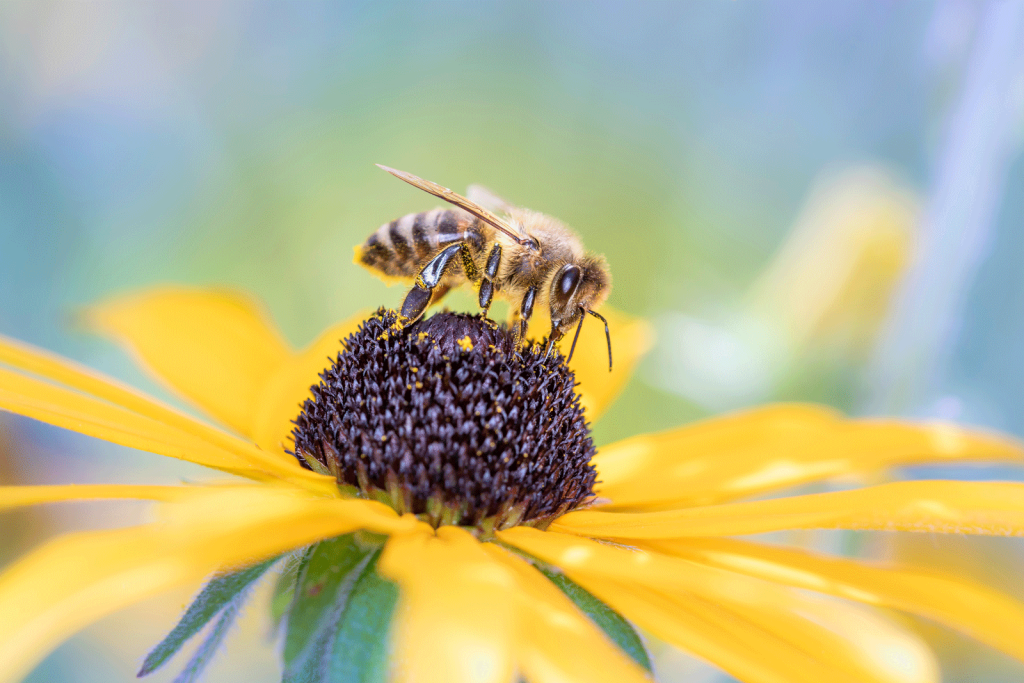
A breakdown of CP42 (Pollinator Habitat) and how it compares to other CRP practices in terms of benefits, seed mix requirements, and long-term success.
The Conservation Reserve Program (CRP) offers a wide range of practice types, each designed to address specific environmental goals, from reducing erosion to improving wildlife habitat. Among them, CP42: Pollinator Habitat stands out for its unique focus on supporting pollinators like bees, butterflies, and other beneficial insects.
At All Native Seed, we supply seed mixes for a variety of CRP practices and often work with landowners trying to decide which is the best fit for their goals and land. Let’s explore the key features of CP42 and compare it with other common CRP practices to help you make an informed decision.
What Is CP42: Pollinator Habitat?
CP42 is a CRP practice specifically designed to establish and support habitat for pollinators by planting diverse mixes of native wildflowers and grasses. These plantings offer nectar and pollen sources throughout the growing season and provide cover for nesting and overwintering.
CP42 Objectives:
- Enhance pollinator populations, including honeybees and native bees
- Support monarch butterflies and other at-risk species
- Improve plant diversity and ecosystem health
- Increase pollination services to surrounding crops
CP42 vs. Other CRP Practices: A Side-by-Side Comparison
| CRP Practice | Primary Focus | Seed Mix Requirements | Wildlife Benefit | Pollinator Value | Establishment Timeline |
| CP42: Pollinator Habitat | Pollinators, biodiversity | High diversity (forbs + grasses); bloom throughout seasons | Moderate–High | Very High | Moderate (2–3 years to maturity) |
| CP2: Native Grasses | Erosion control, wildlife | Warm-season grasses, low forb content | High for ground birds | Moderate | Moderate |
| CP1: Introduced Grasses | Erosion control, low maintenance | Introduced cool-season grasses and legumes | Moderate | Low | Fast (1–2 years) |
| CP4D: Permanent Wildlife Habitat | Upland game and songbirds | Native grasses and forbs, shrubs optional | Very High | High | Moderate |
| CP23: Wetland Restoration | Hydrology and waterfowl habitat | Wetland-adapted grasses and sedges | High for waterfowl | Low–Moderate | Variable (based on hydrology) |
Seed Mix Requirements for CP42
Unlike many CRP practices that focus primarily on grasses, CP42 seed mixes must include a minimum of 9 species of native wildflowers (forbs) and 3 native grasses. Other key requirements include:
- At least 3 wildflower species must bloom in each of the spring, summer, and fall seasons
- Wildflowers must make up a higher proportion of the mix than other CRP practices
- All species must be regionally adapted and NRCS-approved
At All Native Seed, our CP42 seed mixes are fully compliant with NRCS guidelines and tailored to your local ecoregion for optimal establishment and performance.
Benefits of CP42 Pollinator Habitat
Boosts Crop Yields
By supporting pollinator populations near agricultural fields, CP42 plantings can help increase the productivity of crops that rely on pollination.
Supports At-Risk Species
Pollinators like monarch butterflies and native bees are experiencing rapid decline. CP42 habitats directly address this issue.
Enhances Biodiversity
With high plant species diversity, CP42 plantings create resilient ecosystems that support insects, birds, and other wildlife.
Educational and Community Value
These plantings are often used for outreach and education, showcasing the importance of pollinators and conservation.
Challenges and Considerations
While CP42 offers many benefits, it also comes with challenges:
- Establishment takes time: Wildflowers can be slow to germinate and compete with weeds during the first 1–2 years.
- Weed management is critical: Mowing during the first year and spot treatments in year two may be needed.
- Upfront seed cost is higher: High diversity mixes are more expensive than standard CRP grasses, but the ecological return is significant.
With proper site prep and management, these challenges are temporary and the long-term payoff is worth it.
Is CP42 Right for Your Land?
Consider CP42 if:
- You’re interested in supporting pollinators, monarchs, and biodiversity
- You’re managing land near orchards, vegetable crops, or other pollinator-dependent farms
- You’re willing to invest time in establishment and weed management
- You want to add beauty and color to your CRP acreage
All Native Seed: Your CP42 Partner
We specialize in high-quality, NRCS-compliant CP42 seed mixes that are tailored to your region and conservation goals. Our team can help you:
- Select the right mix of native wildflowers and grasses
- Ensure compliance with USDA and NRCS guidelines
- Support you through establishment, management, and long-term success
Choosing the Right Practice for Your Goals
CP42 offers exceptional benefits for pollinators, wildlife, and the environment, but it’s just one of many CRP options. By understanding the purpose and requirements of each practice, you can select the one that best fits your land and conservation goals.
Want help getting started? Contact All Native Seed today to learn more about CP42 and other CRP seed mix options. Together, we’ll build a healthy, resilient habitat from the ground up.
